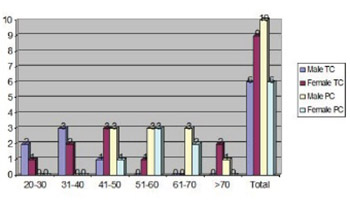Comparison of Complications and Dialysis Adequacy Between Temporary and Permanent Tunnelled Catheter for Haemodialysis
DOI:
https://doi.org/10.17305/bjbms.2009.2776Keywords:
haemodialysis, permanent tunnelled catheters, temporary catheter, dialysis adequacyAbstract
Number of hemodialysis patients each day is increasing. The quality of their lives is largely determined by the quality of hemodialysis treatment. One of the most important factors is the type of applied blood approach. The type of blood approach in the most case is artery venous fistula, permanent, temporary catheters, grafts. Any complications of blood strand approach inevitably leads to lower quality of hemodialysis treatment which is connected with not adequate dialysis and poorer general state of patients. Our research was carried out as a prospective study, for the period of 36 months. In the study were included 31 patients, which are on chronic haemodialysis treatment. During this study, we are followed all complications, which occurred at temporary, and permanent tunneled haemodialysis catheters. Complications have occurred in terms of thrombotic problems, low blood flow, occurrence of infection. All patients are divided in two groups, 16 patients with permanent and 15 patients with temporary catheters. In the course of the study was analyzed blood flow and dialysis adequacy (Kt/Vdp) as well as complications and results was compared with randomly selected 16 patients who haemodialysis treatment performed by artery venous fistula (AVF). Two patients were lost to further follow-up to the end of the study. 26 patients at the end of the study had functional catheters, while in the case of 3 patients the catheter was removed. Infection was found in 10 patients while thrombotic complications were observed in 27 cases regardless of catheter type. Mean blood flow in patients with permanent catheter was significantly higher (296,9+/-28,45 cm3/min) compared to patients with temporary catheter (226,3+/-39,8 cm3/min) (p<0,001). Kt/Vdp delivered was 1,22+/-0,15 on patients with permanent catheter and 1,30+/-0,18 for artery venous fistula (AVF) access respectively. The loss of dialysis efficacy using catheters was estimated at 6%. However, in all cases Kt/Vdp values remained above the recommended values (Kt/Vdp > or = 1,2).
Citations
Downloads

Downloads
Published
Issue
Section
Categories
How to Cite
Accepted 2017-12-07
Published 2009-11-20









